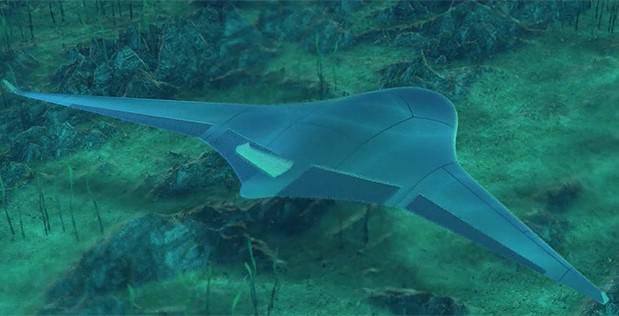Last week DARPA awarded contracts to Northrop Grumman Systems Corporation and Martin Defense Group (formerly Navatek) to build demonstration versions of the new Manta Ray unmanned underwater vehicle. They also awarded a separate contract to Metron for Manta Ray’s most important feature: an energy-harvesting system to power it indefinitely, allowing the robot sub to carry out missions lasting months or years without returning to base or refueling.

The sleek lines of the Manta Ray provide minimum drag and maximum efficiency
DARPA
According to the program’s home page, Manta Ray will demonstrate key technologies to enable a new class of “long duration, long range, payload-capable” robot submarines, capable of “persistent operations in forward environments.” Being payload capable suggests that the Manta Ray could carry anything from a small towed sonar array for submarine detection to acoustic sensors for placing on the seabed, to electronic warfare equipment — or maybe the U.S. Navy’s new Hammerhead mine, designed to be delivered by unmanned subs. This is the second round of funding for Manta Ray after contracts awarded last year, suggesting that the program is well on course.
DARPA describes the work involved, including autonomy to cope with obstacles and deal with the unexpected, such as system failures. Manta Ray will have artificial intelligence to identify and respond to other vessels and submarines, plus new sensors. Other developments include mitigating marine biofouling, which has been a problem ever since barnacles first encountered wooden ships, and is still an issue for modern vessels on prolonged deployment.
The biggest challenge though is power. While new giant robot submarines like the U.S. Navy’s Orca, due in service by 2023, will carry out missions lasting 90 days with conventional power sources, Manta Ray aims for vastly greater endurance by harvesting energy form the sea to recharge itself. This is one reason for its unusual shape: it needs minimum drag to make the best possible use of limited power reserves. It also make the sub highly stealthy.
The energy harvesting concept has already been proven for U.S. Navy unmanned surface vessels, like the Wave Glider boats that washed ashore in Scotland recently. These use a combination of solar power and wave energy for propulsion and to power their electronics, so are effectively unlimited. In 2020, a Wave Glider arrived in Australia after traveling for more than a year and over 16,000 kilometers from San Francisco. Such vessels are used for long-range anti-submarine patrols and other more clandestine missions.
Powering underwater vehicles is more challenging, as they do not have access to either solar or wave power. The most established method is the thermal engine, like the one developed by Teledyne Webb with funding from the Office of Naval Research in the early 2000s. The warmth of the surrounding water heats up a series of tubes filled with wax mounted on the craft. The wax expands as it warms, producing enough force to compress a reservoir of nitrogen at high pressure. This can be used to change buoyancy – the glider’s method of propulsion – or to generate electricity. Manta Ray contenders Northrop Grumman
NOC
Other possible methods of energy harvesting include thermoelectric modules, recently demonstrated by researchers from the University of Glasgow. These use the temperature difference between different parts of the vehicle to produce a small but significant electric current – enough, the researchers say, to power an unmanned underwater vehicle. Boeing
BA

An earlier image of the Manta Ray shows it equipped with an energy-harvesting ‘kite’ which extracts … [+]
DARPA
A previous image released by the Manta Ray project team suggests another possible power source, showing the craft anchored to the sea bed while a smaller vehicle glides above it on a tether. This is the ‘underseas kite’ developed at North Carolina State University for DARPA in association with Navatek, another of the Manta Ray contenders.
Like the power-generation kites being developed as an alternative to wind turbines, the device uses the different flow of water at different ‘altitudes.’ Lead Investigator Chris Vermillion of NC State has spent a decade developing models and control systems for tethered energy-harvesting systems, and his team is working with oceanographers to ensure that the kite will always finds the strongest current. Once the Manta Ray is recharged, it winches in the kite and raises anchor again.
However, there may be no outright winner and several different methods of energy harvesting may be effective.
“Manta Ray performers have each taken unique approaches to solving the wide range of challenges related to UUV endurance,” program manager Commander Kyle Woerner, said in the statement details the latest contracts. “To me, this is a clear sign we are tackling a complex problem without a clear ‘one size fits all’ solution.”
This suggests that DARPA may push ahead with several different Manta Ray designs for different missions – deep ocean versus littoral, or temperate versus arctic. In any case, the challenge of powering robot submarines indefinitely is in the process of being overcome. This is likely to transform the field of underwater warfare, as it means a large, manned, nuclear-powered sub is not needed to maintain a permanent presence in disputed waters. In future the biggest threat may not be manned submarines but shoals of lurking Manta Rays.
This article is auto-generated by Algorithm Source: www.forbes.com


